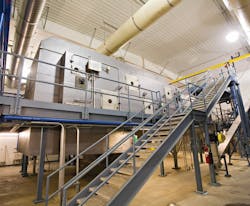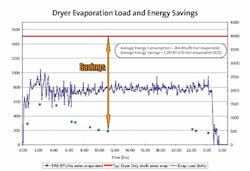The Client’s Needs
The City of Buffalo was faced with numerous challenges such as rising disposal costs, odor issues, and an increase in plant capacity due to the expected increase in population from approximately 15,000 to 30,000 by 2025. Furthermore, the EPA 503 Class A disposal standards needed to be met, as well as meeting the requirements in the limited site footprint.
Process Solution
The BioCon® Drying Process removes moisture from biosolids via thermal drying. Dewatered sludge cake is pumped from a bin into the dryer cabinet through oscillating depositors that extrude thin ribbons through nozzles onto a slowly moving belt located inside the dryer. The ribbons provide a large drying surface area for safe and efficient drying at temperatures less than a conventional oven (< 350°F).
Heat is transferred to the biosolids by circulating air between heat exchangers and biosoild ribbons. Moisture is removed from the drying air by continuously extracting a portion of the air from the dryer, transferring it through a condenser and back to the dryer. The temperature during the drying process decreases as the solids dry. The temperature is the highest when biosolids enter the dryer and the lowest when dry solids exit the dryer. Screw conveyers transport the solid material from the dryer to a solids hopper for utilization as fuel in the energy recover system.
The processes allowed the plant to increase its’ biosolids capacity to 1,850 tons of dry solids per year. The ERS provides over 80% of heat for the dryer from renewable fuels, and reduces the biosolids mass by 95%.
Biosolids and BioEnergy Solutions
Kruger offers both Biosolids and BioEnergy options for various configurations for different styles of plants. Benefits include up to 90% operational savings over disposal costs, Class A biosolids for beneficial reuse and a payback on investment in as little as 3.5 years. These solutions are for plants with or without digestion, are environmentally friendly and “Green Solutions,” as well as can potentially provide carbon credits and renewable energy credits to plants.
Kruger’s solutions include BioEnergy Drying and:
- Digester Energy Exchange
- Engine Heat Recovery
- Energy Recovery System
Conclusion
The effectiveness of Kruger’s BioCon® Dryer and ERS systems allowed the Buffalo WWTP to reduce the amount of biosolids that can be safely and easily handled. This solution was executed in a small footprint that contains the odor and meets the Class A requirements while also saving the plant 70-80% of the required thermal energy that leads to a smaller carbon footprint.
Editor's Note: Scranton Gillette Communications and the SGC Water Group are not liable for the accuracy, efficacy and validity of the claims made in this piece. The views expressed in this content do not reflect the position of the editorial teams of Water & Wastes Digest, Water Quality Products and Storm Water Solutions.

